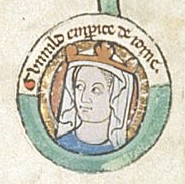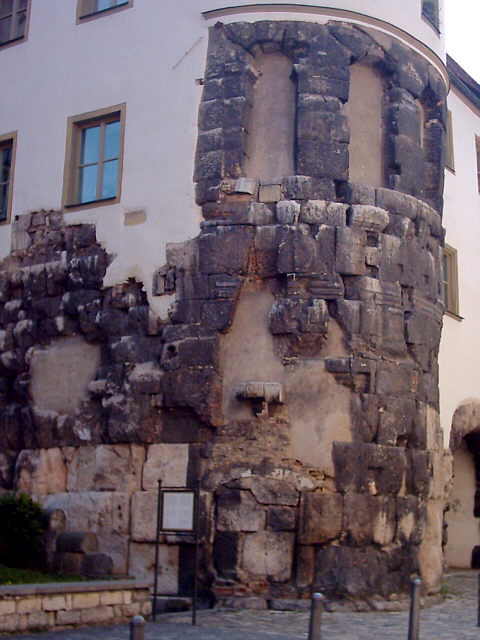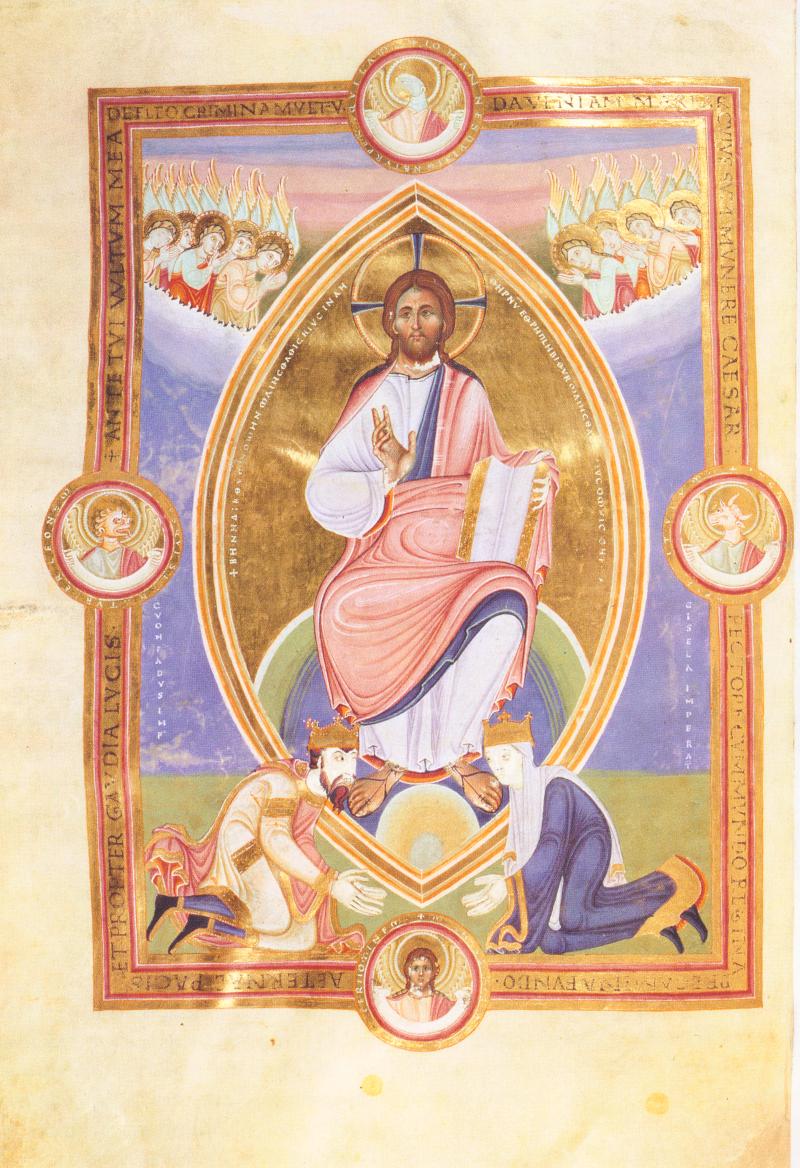|
Conrad II, Duke Of Bavaria
Conrad II (September or October 1052, in Regensburg – 10 April 1055, in Regensburg), called the Child, was the duke of Bavaria from 1054 to 1055. He was the second son of the Emperor Henry III and his second wife, Agnes of Poitou. He was briefly appointed duke of Bavaria, which had been held by his elder brother Henry Henry may refer to: People and fictional characters * Henry (given name), including lists of people and fictional characters * Henry (surname) * Henry, a stage name of François-Louis Henry (1786–1855), French baritone Arts and entertainmen .... He died soon after and was replaced by Henry. If Conrad I is not numbered (because of his alternative name Cuno), Conrad the Child is sometimes numbered Conrad I. References 1052 births 1055 deaths 11th-century dukes of Bavaria Sons of emperors Sons of kings Monarchs who died as children Children of Henry III, Holy Roman Emperor {{Germany-duke-stub ... [...More Info...] [...Related Items...] OR: [Wikipedia] [Google] [Baidu] |
Duke Of Bavaria
The following is a list of monarchs during the history of Bavaria. Bavaria was ruled by several dukes and kings, partitioned and reunited, under several dynasties. Since 1918, Bavaria has been under a republican form of government, and from 1949, Bavaria has been a democratic States of Germany, state in the Federal Republic of Germany. Monarchs of Bavaria Ducal Bavaria (also known as the "Old Stem duchy") Agilolfing dynasty Around 548 the kings of the Franks placed the border region of Bavaria under the administration of a duke—possibly Frankish or possibly chosen from amongst the local leading families—who was supposed to act as a regional governor for the Frankish king. The first duke we know of, and likely the first, was Gariwald, or Garibald I of Bavaria, Garibald I, a member of the powerful Agilolfing family. This was the beginning of a series of Agilolfing dukes that was to last until 788. Carolingian dynasty and dominion from the Holy Roman Empire The kings (la ... [...More Info...] [...Related Items...] OR: [Wikipedia] [Google] [Baidu] |
Henry IV, Holy Roman Emperor
Henry IV (; 11 November 1050 – 7 August 1106) was Holy Roman Emperor from 1084 to 1105, King of Germany from 1054 to 1105, King of Italy and List of kings of Burgundy, Burgundy from 1056 to 1105, and Duke of Bavaria from 1052 to 1054. He was the son of Henry III, Holy Roman Emperor—the second monarch of the Salian dynasty—and Agnes of Poitou. After his father's death on 5 October 1056, Henry was placed under his mother's guardianship. She made grants to German aristocrats to secure their support. Unlike her late husband, she could not control the election of the popes, thus the idea of the Libertas ecclesiae, "liberty of the Church" strengthened during her rule. Taking advantage of her weakness, Archbishop Anno II of Cologne kidnapped Henry in April 1062. He administered Germany until Henry came of age in 1065. Henry endeavoured to recover the royal estates that had been lost during his minority. He employed low-ranking officials to carry out his new policies, causing disco ... [...More Info...] [...Related Items...] OR: [Wikipedia] [Google] [Baidu] |
Henry III, Holy Roman Emperor
Henry III (, 28 October 1016 – 5 October 1056), called the Black () or the Pious, was Holy Roman Emperor from 1046 until his death in 1056. A member of the Salian dynasty, he was the eldest son of Conrad II and Gisela of Swabia. Henry was raised by his father, who made him Duke of Duchy of Bavaria, Bavaria in 1026, appointed him co-ruler in 1028 and bestowed him with the duchy of Swabia and the Kingdom of Burgundy ten years later in 1038. The emperor's death the following year ended a remarkably smooth and harmonious transition process towards Henry's sovereign rule, that was rather uncharacteristic for the Ottonian dynasty, Ottonian and Salian dynasty, Salian monarchs. Henry succeeded Conrad II as Duke of Carinthia and King of Italy and continued to pursue his father's political course on the basis of ''virtus et probitas'' (courage and honesty), which led to an unprecedented sacral exaltation of the kingship. In 1046 Henry ended the History of the papacy (1048–1257), papal s ... [...More Info...] [...Related Items...] OR: [Wikipedia] [Google] [Baidu] |
Agnes Of Poitou
Agnes of Poitou ( – 14 December 1077) was the queen of Germany from 1043 and empress of the Holy Roman Empire from 1046 until 1056 as the wife of Emperor Henry III. From 1056 to 1061, she ruled the Holy Roman Empire as regent during the minority of their son Henry IV. After the death of her husband, she proved an inexperienced regent unable to effectively assert her power and secure loyal allies. In Germany, she is still remembered as a sympathetic historical figure, even if a flawed politician. Early life Agnes was the daughter of the Ramnulfid Duke William V of Aquitaine (d. 1030) and Agnes of Burgundy and as such a member of the Ramnulfid family. Empress Agnes married King Henry III of Germany in November 1043Munster cites November 21; Jackson-Laufer cites November 1 at the Imperial Palace Ingelheim. She was his second wife after Gunhilda of Denmark, who had died, possibly from malaria, in 1038. This marriage helped to solidify the Empire's relationships w ... [...More Info...] [...Related Items...] OR: [Wikipedia] [Google] [Baidu] |
Regensburg
Regensburg (historically known in English as Ratisbon) is a city in eastern Bavaria, at the confluence of the rivers Danube, Naab and Regen (river), Regen, Danube's northernmost point. It is the capital of the Upper Palatinate subregion of the state. With more than 150,000 inhabitants, Regensburg is the List of cities in Bavaria by population, fourth-largest city in the State of Bavaria after Munich, Nuremberg and Augsburg and the eighth-largest of all List of cities and towns on the river Danube, cities on the river Danube. From its foundation as an imperial Roman river fort, the city has been the political, economic and cultural centre of the surrounding region. Later, under the rule of the Holy Roman Empire, it housed the Perpetual Diet of Regensburg. The medieval centre of the city was made a UNESCO World Heritage Site in 2006 because of its well-preserved architecture, being the biggest medieval city site north of the Alps, and the city's historical importance for assembli ... [...More Info...] [...Related Items...] OR: [Wikipedia] [Google] [Baidu] |
Duke Of Bavaria
The following is a list of monarchs during the history of Bavaria. Bavaria was ruled by several dukes and kings, partitioned and reunited, under several dynasties. Since 1918, Bavaria has been under a republican form of government, and from 1949, Bavaria has been a democratic States of Germany, state in the Federal Republic of Germany. Monarchs of Bavaria Ducal Bavaria (also known as the "Old Stem duchy") Agilolfing dynasty Around 548 the kings of the Franks placed the border region of Bavaria under the administration of a duke—possibly Frankish or possibly chosen from amongst the local leading families—who was supposed to act as a regional governor for the Frankish king. The first duke we know of, and likely the first, was Gariwald, or Garibald I of Bavaria, Garibald I, a member of the powerful Agilolfing family. This was the beginning of a series of Agilolfing dukes that was to last until 788. Carolingian dynasty and dominion from the Holy Roman Empire The kings (la ... [...More Info...] [...Related Items...] OR: [Wikipedia] [Google] [Baidu] |
Emperor Henry III
Henry III (, 28 October 1016 – 5 October 1056), called the Black () or the Pious, was Holy Roman Emperor from 1046 until his death in 1056. A member of the Salian dynasty, he was the eldest son of Conrad II and Gisela of Swabia. Henry was raised by his father, who made him Duke of Duchy of Bavaria, Bavaria in 1026, appointed him co-ruler in 1028 and bestowed him with the duchy of Swabia and the Kingdom of Burgundy ten years later in 1038. The emperor's death the following year ended a remarkably smooth and harmonious transition process towards Henry's sovereign rule, that was rather uncharacteristic for the Ottonian dynasty, Ottonian and Salian dynasty, Salian monarchs. Henry succeeded Conrad II as Duke of Carinthia and King of Italy and continued to pursue his father's political course on the basis of ''virtus et probitas'' (courage and honesty), which led to an unprecedented sacral exaltation of the kingship. In 1046 Henry ended the History of the papacy (1048–1257), papal s ... [...More Info...] [...Related Items...] OR: [Wikipedia] [Google] [Baidu] |
Emperor Henry IV
Henry IV (; 11 November 1050 – 7 August 1106) was Holy Roman Emperor from 1084 to 1105, King of Germany from 1054 to 1105, King of Italy and Burgundy from 1056 to 1105, and Duke of Bavaria from 1052 to 1054. He was the son of Henry III, Holy Roman Emperor—the second monarch of the Salian dynasty—and Agnes of Poitou. After his father's death on 5 October 1056, Henry was placed under his mother's guardianship. She made grants to German aristocrats to secure their support. Unlike her late husband, she could not control the election of the popes, thus the idea of the "liberty of the Church" strengthened during her rule. Taking advantage of her weakness, Archbishop Anno II of Cologne kidnapped Henry in April 1062. He administered Germany until Henry came of age in 1065. Henry endeavoured to recover the royal estates that had been lost during his minority. He employed low-ranking officials to carry out his new policies, causing discontent in Saxony and Thuringia. Henry crushed ... [...More Info...] [...Related Items...] OR: [Wikipedia] [Google] [Baidu] |
Conrad I, Duke Of Bavaria
Conrad I ( 1020 – 5 December 1055), also known as Cuno or Kuno, was the duke of Bavaria from 1049 to 1053. He was of the Ezzonen family, his parents being Liudolf, Count of Zütphen and eldest son of Ezzo, Count Palatine of Lorraine, and Matilda. For this, he is sometimes called ''Conrad of Zutphen''. After eighteen months of vacancy since the death of Henry VII, the duchy of Bavaria was filled on 2 February 1049 by the Emperor Henry III with Cuno. Cuno was the possible successor of the childless emperor. He was not the choice of the Bavarian nobility, but was intended to draw the duchy closer to the crown. This failed, for Cuno married against the will of the emperor when he wed Judith of Schweinfurt, daughter of Otto III, Duke of Swabia. He tried to increase his power in Bavaria and was in conflict with Gebhard III, Bishop of Regensburg. Finally, he was summoned to a Christmas court at Merseburg in 1052–1053 and there deposed. He was replaced early the next year by Hen ... [...More Info...] [...Related Items...] OR: [Wikipedia] [Google] [Baidu] |
Salian Dynasty
The Salian dynasty or Salic dynasty () was a dynasty in the High Middle Ages. The dynasty provided four kings of Germany (1024–1125), all of whom went on to be crowned Holy Roman emperors (1027–1125). After the death of the last Ottonian emperor in 1024, the Kingdom of Germany and later the entire Holy Roman Empire passed to Conrad II, a Salian. He was followed by three more Salian rulers: Henry III, Henry IV, and Henry V. They established their monarchy as a major European power. The Salian dynasty developed a permanent administrative system based on a class of public officials answerable to the crown. Origins and name Modern historians suppose that the Salians descended from the Widonids, a prominent noble kindred emerging in the 7th century. Their estates were located at the confluence of rivers Moselle and Saar and they supported the Carolingians. The Widonids' eastward expansion towards the river Rhine started after they founded Hornbach Abbey in th ... [...More Info...] [...Related Items...] OR: [Wikipedia] [Google] [Baidu] |
1052 Births
Year 1052 ( MLII) was a leap year starting on Wednesday of the Julian calendar. Events By place England * Summer – Godwin, Earl of Wessex, sails with a large fleet up the Thames to London, forcing King Edward the Confessor to reinstate him into his previous position of power. Africa * Battle of Haydaran: The Zirid dynasty is defeated by the invading Bedouin Arab tribes of the Banu Hilal. By topic Religion * Byōdō-in, a Japanese Buddhist temple (located in the Kyoto Prefecture), changes its name by order of Fujiwara no Yorimichi. Births * May 23 – Philip I ("the Amorous"), king of France (d. 1108) * September/October – Conrad II ("the Child"), duke of Bavaria (d. 1055) * Agnes of Aquitaine, countess of Savoy (approximate date) * Dirk V, count of Friesland (west of the Vlie) (d. 1091) * Edgar Ætheling, uncrowned king of England (d. c. 1126) (approximate date) * Gleb Svyatoslavich, Kievan prince (approximate date) * Jón Ögmundsson ... [...More Info...] [...Related Items...] OR: [Wikipedia] [Google] [Baidu] |
1055 Deaths
1055 ( MLV) was a common year starting on Sunday of the Julian calendar. Events By place Byzantine Empire * January 11 – Emperor Constantine IX Monomachos dies after a 12½-year reign at Constantinople. He is succeeded by Theodora (a sister of the former Empress Zoë), who is proclaimed by the imperial guard (with strong opposition from the council) as empress of the Byzantine Empire. Europe * King Ferdinand I of León ("the Great") begins his campaign against al-Andalus. He conquers Seia from the Christian allies of the Muslim taifas. In a drive to consolidate his southern border in Portugal he re-populates the city of Zamora with some of his Cantabrian (''montañeses'') subjects. England * October 24 – Ælfgar, Earl of Mercia, is outlawed by the witan ("meeting of wise men"). In revenge he builds a force and allies himself with the Welsh king Gruffydd ap Llywelyn. After defeating Ralph the Timid (a nephew of King Edward the Confessor), they attack ... [...More Info...] [...Related Items...] OR: [Wikipedia] [Google] [Baidu] |









